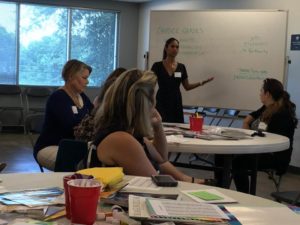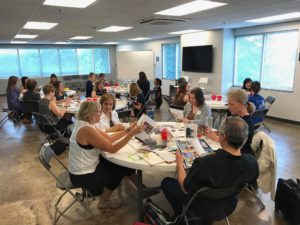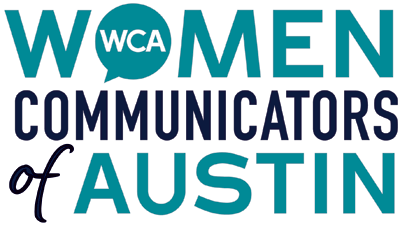Freelancing can feel chaotic. Especially for someone new to working for themselves, freelance work can seem like  something that keeps happening to you rather than something you have control over.
something that keeps happening to you rather than something you have control over.
At Freelance Austin’s June meeting, Candace Gerdes of Mamaste led attendees in a project to help us approach our freelance businesses with more intention: vision boarding.
Taking A Holistic Approach
Before we got to the vision boards themselves, Candace started off the class with a lesson in making sure we take a holistic approach to how we plan our businesses and our overall lives. She started the presentation with an announcement that we were meeting on the new moon, which symbolically means we could come to our vision boarding with a clean slate. Then she led the room in breathing exercises to help us each center our self.
She explained that for professionals, vision boarding can be a good way to create a clear vision for our career and business moving forward, but urged us to make sure and integrate the other parts of our lives into our vision as well. Our businesses influence our relationships, hobbies, and other priorities and vice versa. Over time, not integrating the whole picture will take its toll.
What is Vision Boarding?
As for the exercise itself, a vision board is a collage that provides a visual representation of a person’s goals and values. To help guide us in the exercise, Candace talked about how to understand goals, intentions, and core values:
- Goals have a result. They’re something that’s obtainable.
- Intentions are our why. They guide our goals.
- Core values guide our intentions. They help us decide what really matters to us.
The practice of vision boarding starts by defining these three categories for yourself and then turning them into something physically and visually tangible. Having a visual representation of what you want gives you a guiding vision of what to work toward. Every time you look at it, you get a reminder to check in on the actions and choices you’re making and how they line up with where you want to be.
A vision board should give you focus and help you put your energy toward doing what’s most effective for achieving the things you want.
Building Your Vision Board
Once she’d covered the basics of how to approach vision boarding, we turned to the magazines and poster boards in front of us to get to work. Candace provided a few more important tips to lead the way.
- Remember it’s your unique vision.
Everyone has different goals and priorities and your vision board should fully focus on your own. Candace encourages centering your self and your particular desires in choosing what to add to your board. Ask yourself as you go: do I want this for me, or because of what other people will think?
- Take time to define your core values.
If you don’t know where to start in building a vision board, spending a few minutes considering your core values can be a good starting point. Candace provided attendees a list of possible core values that we could browse to help us identify the ones that meant the most to us. If you could use a list to start with when vision boarding at home, there’s one available here.
- Be intentional and authentic.
Be very careful when putting together your vision board that you’re creating a true representation of what you want. For each visual that goes on the board, really consider the “why” behind it and make sure it matches up with the core values and goals you have in mind.
- Allow room for reflection, but not criticism.
Candace emphasized the importance of being gentle with yourself. There’s room in vision boarding to reflect on your choices and the intentions behind them, but there’s not room for criticism. This should be a positive exercise that helps you better organize your thoughts around what you want out of life, not an opportunity to beat yourself up for what you don’t have yet.
- Keep at it.
Vision boarding isn’t a one-time activity. Once you’ve started a vision board, you should keep adding to it and watching it evolve over time. It’s ok for your goals to change, as long as you hold yourself to being intentional about each new decision you make.
And don’t get hung up on results. When it comes to meeting your goals, intention matters more than success. Doing your best to stay on the right path as you go matters more than if where you end matches exactly what you had in mind.
Even if you missed the meeting this time, this is a practice you can do at home. You can use magazines and a poster board like we did, or you can turn to the internet and use a program like Pinterest. Be sure to check out our Facebook page to see more pictures of our meeting, in addition to getting ideas for your next vision board!
Our July 11 meeting will be on gaining the confidence you need for freelance success. Put it on your calendar now and be sure to join us.
- 5 Good Reasons to End a Client Relationship (And How to Do It) - January 11, 2019
- Finding an Effective Freelance Routine with Ashley Abedini - December 14, 2018
- Freelancing for Work Life Balance with Kristen Dunn - October 12, 2018
